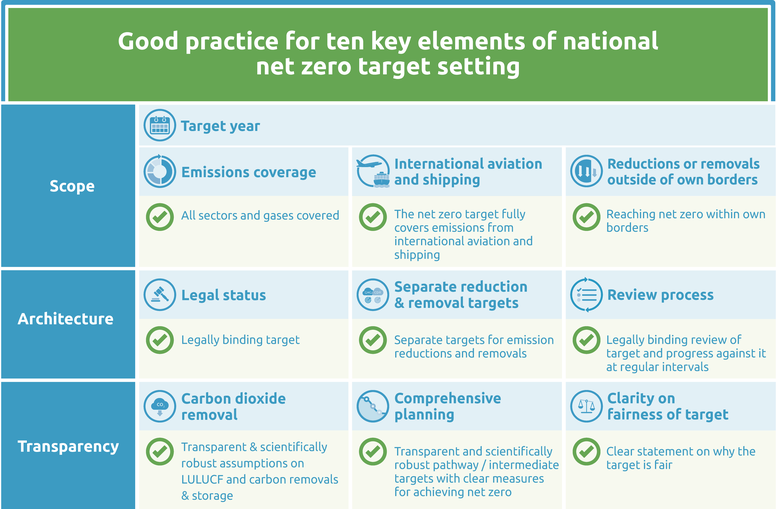Net zero targets
Summary
We evaluate the net zero target as: Average.
The South Korean government included its commitment of carbon neutrality by 2050 in its updated NDC and Long-Term Strategy (LTS) (Republic of Korea, 2020, 2021b). The carbon neutrality target is enshrined in law through the Carbon Neutrality Act, which was passed in August 2021 (Ministry of Environment, 2021) and enforced in March 2022 (Ministry of Environment, 2022b).
In October 2021, South Korea published two draft pathways to net zero emissions in 2050 – the 2050 carbon neutrality scenarios (Republic of Korea, 2021c). Improving on the LTS, the 2050 pathways explicitly state that the net zero target does not include overseas reductions. However, South Korea is still not explicit in its coverage of GHGs, and the target review process lacks detail.
The two scenarios phase out coal before 2050, although the exact phase-out year remains unclear. One of the scenarios also phases out natural gas. The other one allows for some natural gas, and has a higher amount of CCUS in turn to compensate the emissions. Both scenarios assume a sink of about 25 MtCO2e from forestry in 2050.
South Korea has progressed the legal implementation of the carbon neutrality target, and the CAT now evaluates the “comprehensive planning” as a given. Nevertheless, the government still has not made the emissions coverage explicit, a prerequisite for an overall evaluation of “acceptable”.
CAT analysis of net zero target
Scope
- Target year – South Korea aims to reach net zero emissions by 2050.
- Emissions coverage – South Korea provides no explicit information on the target’s emissions coverage. South Korea aims to achieve ‘carbon neutrality’ by 2050 – a term which typically means net zero CO2 emissions (IPCC, 2018). However, in its LTS and 2050 carbon neutrality scenarios, the government lists methane reduction measures and presents targets in units of CO2 equivalents (MtCO2e). The Korean Government would need to be explicit about the emissions coverage for the rating of this element to change. For the quantification of the 2050 target value CAT assumes a coverage of all gases (see assumptions section).
- International aviation and shipping – South Korea provide no information on its intention to cover international aviation and shipping.
- Reductions or removals outside of own borders – South Korea’s 2050 carbon neutrality scenarios, published in October 2021, state that its net zero target does not include overseas emissions reductions (Republic of Korea, 2021c).
Target architecture
- Legal status – The carbon neutrality target is included in South Korea’s LTS (Republic of Korea, 2020) and has been enshrined in law through Carbon Neutrality Act (Ministry of Environment, 2021) and enforced in March 2022 (Ministry of Environment, 2022b).
- Separate reduction & removal targets – South Korea’s draft 2050 net zero pathways plan for a LULUCF sink of 25.3 MtCO2e in 2050. The document lists strengthening forest circulation management and expanding afforestation and reforestation but does not reference any specific plans. Earlier in 2021, the Korea Forest Service announced a reforestation plan that could lead to a removal of 34 million tonnes CO2 (Republic of Korea, 2021d). The plan, which aims to log and replant over 70% of South Korea’s mature forests, received a lot of criticism as it is based on a new definition of “old trees” and contested research on the lifetime carbon absorption of trees (Bang-Hyun & Kim, 2021; KFEM, 2021; Macdonald, 2021). Activists also comment that the estimate of 34 million tonnes CO2 removal is highly inflated (KFEM, 2021).
- Review process – In its LTS, South Korea states that it will regularly review and update its carbon neutral strategy (Republic of Korea, 2020). The Carbon Neutrality Act states that sectoral strategies will be reviewed every five years and that the implementation of the strategy and targets will be assessed. However, the Act does not provide more specific information on this review process.
Transparency
- Carbon dioxide removal – South Korea’s 2050 carbon neutrality scenarios illustrates two different scenarios to reach carbon neutrality, in which it shows the contribution from different sectors, incl. carbon dioxide removals separately. Both scenarios include sinks from LULUCF, one scenario an additional removal through Direct Air Capture (DAC). The plan outlines South Korea’s strategy for achieving these removal and states that forthcoming carbon pricing policy will be a key policy instrument to facilitate reductions across all sectors.
- Comprehensive planning–South Korea’s updated NDC, submitted in December 2021, sets an interim target to reduce emissions by 40% below 2018 levels by 2030 which includes reductions from LULUCF and international credits. The target is a significant improvement on the NDC submitted in December 2020 and it covers the same sector as South Korea’s carbon neutrality target.
The Framework Act on Carbon Neutrality and Green Growth, effective since March 2022, imposes legal procedures and policy measures to achieve carbon neutrality by 2050 (Ministry of Environment, 2022b). The implementation mechanism will be based on a national carbon neutrality master plan, which has a planning period of 20 years (revised every five years), and aligned with that regions will prepare climate plans every ten years. - Clarity on fairness of target – The Korean government has not explained why its net zero target is a fair contribution to the global goal of limiting warming to 1.5°C.
The 2050 carbon neutrality scenarios explicitly mention the need for a fair and just transition to a carbon-neutral society. The document also states that revenues from the forthcoming carbon tax will be used to support vulnerable communities in this transition.
Good practice
The Climate Action Tracker has defined the following good practice for all ten key elements of net zero targets. Countries can refer to this good practice to design or enhance their net zero targets.
Further analysis
Latest publications
Stay informed
Subscribe to our newsletter







